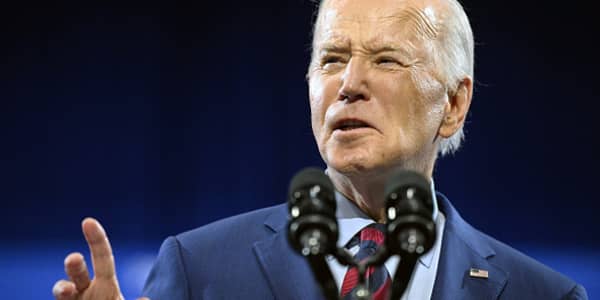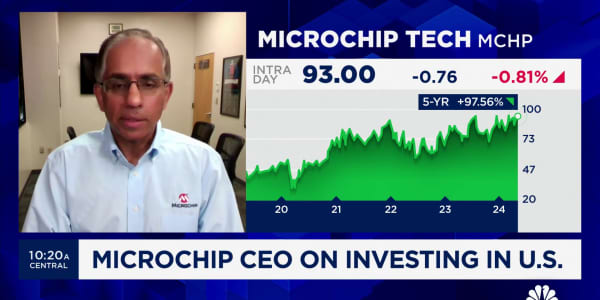Whether it's head count, bonuses, branches or share price, there's not a lot on Wall Street that's moving higher in 2016. Except for activity in mobile products.
Wall Street is diving headlong into digital as funding for start-ups looking to chip into banks' market share appears to have reached a multibillion-dollar crescendo. From 2010 through 2015 the number of fintech investors has mushroomed more than threefold to nearly 900, according to research firm CB Insights. But for big banks, the mobile revolution is only beginning.
In 2012, Bank of America launched mobile checking, and by the end of the year 4 percent of its 19 million customers were cashing checks through their phones rather than at branches. By the end of 2015, the figure grew to 15 percent, according to its most recent earnings report.
It's not the only business at Bank of America migrating to the smartphone, it's just the latest. Among the other conveniences the bank has focused on, it uses the iPhone thumbprint verification tool to positively identify customers and, when they request it, connects them to live customer service specialists. Thanks to the digital security enhancement, customers accessing the bank this way will not find themselves repeating account numbers and passwords after being connected to a service rep.
"You don't have to wait to answer any questions," said Bank of America digital chief Michelle Moore, adding that the app is meant to allow consumers "to access the entire bank from the touch of a thumb."

Bank of America is also in the early stages of rolling out a cardless ATM that offers benefits to the company and to its customers alike. For Bank of America and JPMorgan Chase, the first two big banks to reveal plans for card-less ATMs, using near-field communications to let consumers withdraw cash at machines via smartphone-generated PIN codes means it is cutting down on fraud.
Soon, at JPMorgan Chase and BofA, the "touch" ID will be available on phones other than Apple, after platforms such as Android offer similarly secure functions. The two banks and Wells Fargo have created Spanish-language versions of their mobile apps, as well.
"When we look across all of our businesses, all of them have a need to digitize," said Gavin Michael, head of digital at JPMorgan Chase. "That space has a long way to go. We're very much at day one of the journey."
Banks' mobile products are gaining traction with consumers faster than their desktop offerings did. And for Wall Street, which has already suffered customer data breaches, this is probably ideal. Banks can tailor encryption and security within their apps in a way that Internet browsers cannot. Most banks would probably prefer consumers conducted their online banking activity through a phone, compared to a desktop, or laptop.
"The opportunity for a hacker to get in via a browser is greater than for an app that has security built into it," said Dan Goldstein, an expert on data and regulatory matters and senior director at Treliant Risk Advisors.
Smartphones are also helping ease the burden on banks' hardware. In fact, through features securely providing consumers information such as their current balances without having to sign in to accounts, banks and their new mobile apps are helping reduce traffic to their websites.
JPMorgan's year-over-year increase in "active" mobile customers is 20 percent (to about 23 million consumers) for the fourth quarter of 2015, compared to an 8 percent rise in active online customers. Over the same timeframe, Bank of America's active mobile user head count rose more than 13 percent, compared to less than 2.5 percent growth in its active online users.

Wells Fargo, which had 70 million customers as of Sept. 30, reported in its earnings that its tally of 16.2 million "active" mobile customers at the end of 2015 represented a 14 percent year-over-year increase.
"We are constantly monitoring what customers are doing from different devices," said Katherine McGee, Wells Fargo's head of digital product management for virtual channels. "We're doing a lot to enhance the sales experience from the smartphone."
For Wells Fargo, Bank of America and JPMorgan, representatives said an "active" user constitutes one who has used the app in the last 30 to 90 days. Citigroup, which tracks unique users in the last 30 days, said it saw an increase of more than 22 percent in U.S. mobile users from 2014 to 2015. However, the bank does not publicize its total tally of mobile adoption across its user base.
Most Wall Street banks have focused recently on trimming branches, reducing head count and boosting profitability. But it's not clear that the mobile momentum will do all of these things. Bank of America added thousands of "digital ambassadors" to its retail locations who are trained to guide customers the through mobile and desktop experience; the bank still expects, at least for now, that the mortgage process will still be routed through a home lending specialist.
"You need someone to help you along the way," Moore said.
Even banks without a consumer presence are making moves toward mobile. On Wednesday, Morgan Stanley announced the hire of Naureen Hassan as chief digital officer for wealth management. Hassan, who in 2015 helped her former employer Charles Schwab launch its automated investment advisory service, will start there on March 1.
"This market is clearly more interested in a digital interface," a Morgan Stanley source said. "The next generation of high net worth clients will be even more interested."






